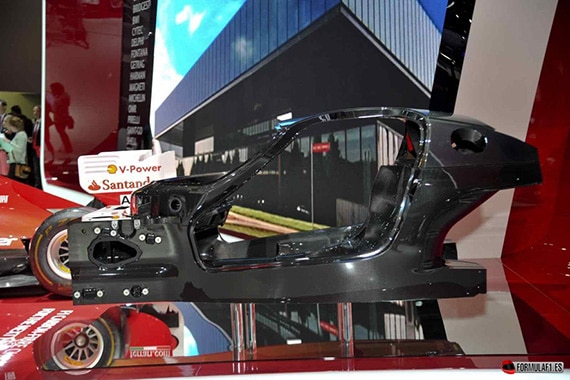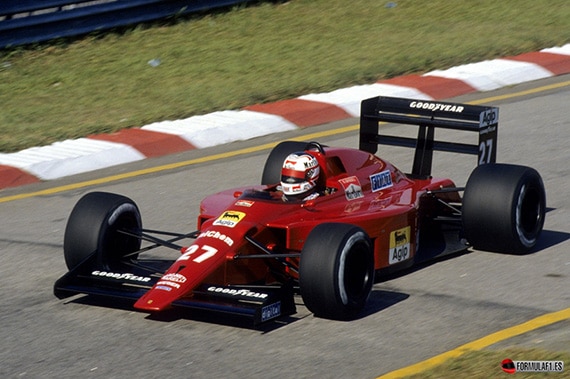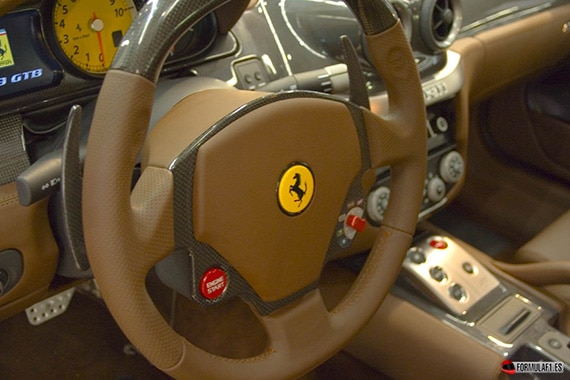There are numerous aspects of road cars where technological or security advances that the teams develop in Formula 1 are felt, creating an influence that for some brands is essential when it comes to justifying the investment in their competition departments.

Carbon fiber chassis
It has rained a lot since the first model with composite chassis influenced by F1 - he Lotus Elite by Colin Chapman in 1957- and for this reason brands such as Ferrari continue to invest in innovating the design and structure of the chassis of their street models, sharing methods, materials, personnel and instruments with their own team. To do this, the brands create working groups where the chief designers of the teams contribute to the development of lighter, stronger and safer chassis.
In addition, we can not only find this technology in the great sports cars of Ferrari, McLaren or Mercedes or in small series of convertibles, but also in large series vehicles, where composites abound more and more with thermoplastic stampable reinforced or resins transfer molding.

carbon ceramic brakes
These brakes are one of the elements most influenced by their development in top competition and especially in Formula 1. While some manufacturers such as Ferrari they offer them serial in their sports cars (since the Enzo in 2002) others like Mercedes or BMW offer them as optional.
The goal of the brands and their suppliers of high performance brakes is to develop simpler and more efficient components. lower cost to comply with the restrictions of medium vehicle manufacturers and try to make this technology available for quality vehicles without belonging to the most extreme sports segment. Right now you can find street vehicles like the Hyundai Genesis Coupe that adopt these high-performance brakes (in its 6L V3,8 version) at a relatively reasonable price.
Carbon ceramic brakes offer excellent performance despite receiving a intensive use offering exceptional wear resistance. Under normal conditions of use, they offer a extended life In addition to reducing the weight of the vehicle, providing the driver with sensations that previously only competition drivers could enjoy.

Gearbox
It's probably about the technology where the F1 It is perceived more clearly in models that we can see in the market. The gearbox design with steering wheel cams It was first used in the Ferrari prototype model 639 from 1988 that never saw the light of day. Finally, the device premiered in competition at the Grand Prix of Brazil from 1989 where Nigel Mansell took the Ferrari 640 to the top of the podium.
The progress that was once made to change gears from the paddles on the steering wheel without the need for a clutch has continued to this day and many high-end sports models offer it as standard. The first models aimed at the public to mount this device were the World T Ferrari in 1992. Only 100 units of this model had it, showing better acceleration figures than the manual version.
Aerodynamics
Being a determining factor in the performance of both single-seaters and large series models, special emphasis has always been placed on aerodynamic design and development. Traditionally, efforts have focused on improving efficiency by increasing the grip aerodynamic and improving the capabilities of the tires both when cornering and when braking, although in the street models, the aim has been to reduce air resistance for lower consumption.
Another aerodynamic aspect to take into account is the bottom of the vehicle, since in the street models of brands such as Ferrari (see models such as the F355, 360 or 599 GTB) the flat bottom has been improved with diffusers and new designs trying to reduce the drag but keeping the grip with a good aerodynamic behavior.

Engines
Few design challenges contribute more to car performance than a low center of gravity that provides the lowest possible weight transfers to the outside tires in curves as well as to the front tires when braking. Maintaining the center of gravity of the single-seater and the road car means making better use of the available traction.
Therefore, the V-layout flat engine is the configuration that keeps the center of gravity lower, placing it just above the surface of the asphalt. The first designs with this arrangement were impractical in competition when the engines were located in the forward position as they interfered with the transmission due to their width, but when the engines in rear position everything changed.
The first single-seater to employ this design was a Ferrari 512 F1 in 1964 with 12 cylinders in V showing great potential. As a result of this heritage, the Ferrari 312B in 1970 it delivered 470 hp at 12.600 rpm, six years later becoming the first engine to deliver more than 500 hp in the generation of three-liter naturally aspirated engines.
The boxer engines, which had given the Scuderia such good results on the track, were intended to be used also in street vehicles, making Ferrari the first and only manufacturer at that time to offer these engines to the public with a 4,4-wheel drive model. .365 liters fitted to the 4 GTXNUMX BB or berlinetta boxer which was shown as a prototype for the first time at the Turin Motor Show in 1971, going into series production in 1973.
The model was relaunched three years later as Ferrari 512 BB with a displacement of 5 liters. This engine was later inherited by the Ferrari Testarossa carrying the boxer concept into the 90's being replaced by the new generation of V12s.

Traction control
It is one of the most studied and refined systems since it compares the speed of the car with the rotation of the tires, detecting any loss of traction preventing an undesirable situation.
The first model to introduce pure and exclusively Formula 1 traction control in a road model was the Ferrari 599 GTB Fiorano. The system was known as F1 Trac and was incorporated into the 599 in 2006 by a team of engineers dedicated to transferring technology from the sports division to the brand's production models. Instead of switching on or off like normal traction control, F1-Trac used predictive software to give more delicate and refined steering control, ideal for driving in the wet or with snow on the road.
The transfer of technology between the competition divisions of the manufacturers and their mass production models can also be seen in other aspects such as the differential, flywheel and even the instrumentation, creating synergies that revert to the industry and promote the justification of the high costs of the teams, as is the case in Mercedes, where part of the board of directors is reluctant to maintain indefinitely the expenses from its Formula 1 team. .
In short, beyond eccentricities and design exercises such as the Renault Twizy RSF1, it is clear that many advances brought by the hand of Formula 1 have ended up in series models helping to make them safer and more efficient.
Article written by Christian Garcia, editor of formulaf1.es, In collaboration with actualidadmotor.com.
What a nice article, congratulations!